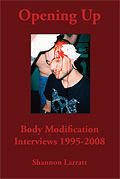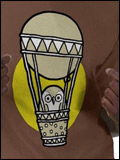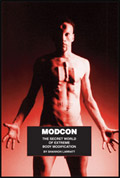I just did a little interview with a Brazilian author. I’m always so paranoid these days that my pain level is distorting my ability to answer properly, be it by making my answers to shallow or be it because I’m in a constant terrible mood that I’m always fighting to keep from leaking out (my “stay calm” tattoo could not be more relevant). So I hope this turned out ok. Please don’t tell me that it is, I’m not saying this to fish for compliments — if you do feel like commenting, comments on the questions or your own counter-answers are always interesting.
*** Piercing as we know it started in the Los Angeles Gay S&M scene. Can you give a brief history of how women started to surface in the body piercing community?
I would not make that statement at all. There have always been piercing societies, documented back to the 1500s, and it has always been about both men and women. It is true that in America, the first piercing studios were opened by gay leather men, so sometimes people think this is where piercing came from, but that’s not true — it’s just who started the first businesses. They deserve a mountain of credit for that of course, but don’t think that it represented the whole piercing community. If you look at other areas, Europe for example, the piercing community had a heterosexual bias. Piercing has never been limited to just one demographic group, and has always been very diverse.
*** Are there any divergences in the way society views modified men and women? If there are, what are the most apparent?
The differences in the way society views modified men and women simply reflects the way society views men and women in general — to generalize, men are tough, women are sexy. Some parts of the body modification community are more socially aware, some are less. As I said, the body modification community is really just a slice of the larger world.
*** Body modification in most of it’s forms is commonly considered an expression of individuality, yet each day we see more and more people modified, many of them with the same tattoo motifs and same piercings. From your point of view, why is this and how did it start?
Humans like to tell themselves that they’re individuals, but we’re herd animals at our core, and are mortally frightened of actually being individuals. They love symbols of individuality but don’t really like being individuals most of the time. In any case, people getting the same modifications as others has always been a significant part of the mod world — if anything, it’s individualism that is new and atypical. Indigenous societies tended to get the same tattoos of course, and then here in the West tattooing has spent much of its history being flash-based, with people selecting their tattoos from a limited menu. Even much custom work draws from a limited iconography. But I think it’s also important to understand that most people don’t see tattooing as making themselves a true individual — they simply see it as separating themselves from the untattooed mainstream. And this attitude is rapidly disappearing as tattooing becomes common to the point of normalcy, making the majority of claims of individuality vapid, shallow, and ludicrous.
*** Tongue piercings and lower back tattoos (rudely called tramp stamps) are commonly associated with both femininity and promiscuity, do you consider this a coincidence?
I think it’s fairly obvious that the sort of person who sees such links is connecting tongue piercing to oral sex — sexual submission being the implication — and the lower back tattoo is linked to intercourse from behind — again, sexual submission being the implication. I don’t think anything here is surprising or coincidental — I’d say it’s quite obvious and mirrors the way the women are treated by men in general (and occasionally how they exhibit themselves to men).
*** In your view, has body modification, other than plastic surgery, been incorporated into the mainstream vision of beauty?
I don’t know if I’d go so far as to say that body modification is part of the mainstream view of beauty, but over the last decade a “tattooed vixen” archetype has certainly developed that markets “edgy” sexuality to the mainstream in a way that they see as both exciting and safe. Given the overall gentrification of body modification, and most subcultural communities due to the Internet overexposing every facet of human expression, this is completely unsurprising.



3 Comments
Hey Shannon,
I think you’re pointing out interesting things throughout the interview on a topic that really doesn’t get the emphasis it should (in general), since the belief we live in some sort of a post-feminist world seems to be so common.
I’m a little saddened, however, by your use of euphemism : why say « the way the women are treated by men in general » and not « average sexism » or « daily consequences of a patriarchal culture » ?
I’m not trying to pick a fight, for I think you did a fine job; just stating that I’d rather see oppression named for what it is.
Cheers,
;) well veg – who here is we – only members of the we with computer access I’d say – but language can’t handle or frame as well as set theory – :)
I enjoyed reading this. Well spoken answers, probably much more thoughtful then what he expected to get. Just curious, is that last remark an ironic reference to you?
Post a Comment